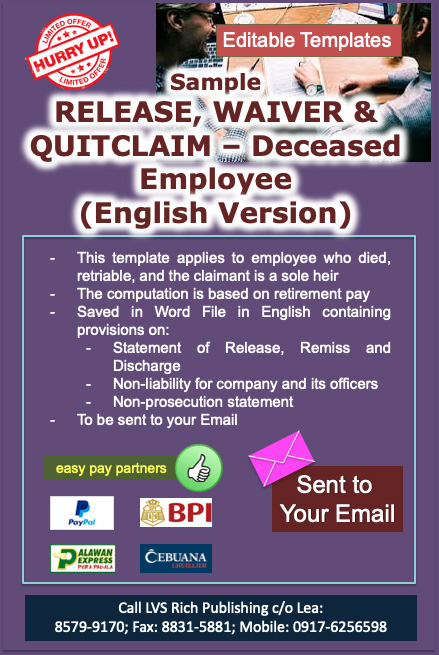Release, Waiver and Quitclaim of Deceased Employee by Sole Heir – Soft Copy Editable Template
₱895.00
DESCRIPTION OF RELEASE, WAIVER AND QUITCLAIM OF SOLE HEIR FOR THE DECEASED EMPLOYEE WHO IS RETIRABLE
This is a soft copy template saved in Word File and editable in Word Document.
This contains the sample terms, conditions, clauses, and provisions of the contract described.
See the Description below to view the Contents of this soft copy template.
This template applies to cases where the employee who is entitled to retirement has resigned but died prior to claiming the retirement benefit. The one claiming the benefit is the child (son in this template).
Further, the company advanced certain expenses in the hospital for the deceased employee.
The claimant is a sole heir. Meaning he is alone and there are no other heirs requiring the Extrajudicial Settlement of Estate. Likewise, he has executed an Affidavit of Sole Heir.
The relative and/or spouse here is the one claiming damages against the company. While the company has several defenses in this case, the company may decide to buy peace and provide financial assistance.
In doing so, the release thereof should be documented to prevent any further action from the claimant against the company or its officers. Thus, a Release, Waiver & Quitclaim may be executed by the spouse, common law partner, or any person acting in behalf of the interests of the deceased person.
Read more..
The draft template here addresses the following concerns:
- The claimant should release and remiss the company and its officers from any claim;
- The claimant clearly states the relationship to the deceased;
- The claimant does not make any statement that will incriminate or establish criminal liability against the alleged actor or any person acting for the company;
The following terms are stated:
- Claimant is of legal age,
- Residence of the claimant
- Declaration of claimant as the duly authorized representative of the family for and in behalf of the deceased person
- Name of the deceased person
- Relationship of the claimant to the deceased person such as being the common law partner / spouse, etc.
- Description of the incident without specifying any suspect or declaring liability;
- Decision of the company to release the fund due for the above deceased as well as financial assistance;
- Statement of release, remiss and forever discharge of the company, its stockholders, Directors, Officers, President, Treasurer, executives, managers, employees, representatives and any other persons working or dealing for and in behalf thereof, from any and all liabilities, damages or injuries caused to claimant and his family or may be caused, as a result of the service not having materialized, and for any other such liabilities, damages or injuries which may now or in the future arise as a result thereof;
- If found hereinafter that there would be any other consequential or resulting damage, liability or injury, whether actual, moral, exemplary or in any other form of damage, not evident as of that time, that the amount given shall constitute as full and final settlement for such damage, liability or injury;
Statement of voluntary, free and unconditional declaration that the claimant and his family have no further claims or right of action, whether past, present, future or contingent, of whatever nature - Statement of waiver of any and all claims and causes of actions or judgments of any tribunal;
- Statement not to institute any action, whether civil, criminal, labor or administrative against the company, its directors, officers, employees, agents and clients;
- Statement that any and all actions which may have been commenced are deemed and considered voluntary withdrawn by me and he will no longer testify or continue to prosecute said action(s); and
- Statement that the claimant fully understands all the statements made.
close
















